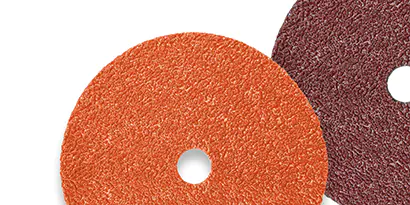
1. Getting Pressure Right
The efficiency and effectiveness of using fiber discs heavily depend on the application of the correct downforce pressure. Applying too much pressure can lead to several issues, including excessive material removal, premature disc wear, and increased heat generation. On the other hand, insufficient pressure might result in inadequate material removal, prolonging the task unnecessarily. To achieve the optimal downforce pressure, fabricators should follow these steps:
- Start Light: When beginning a task, start with a gentle touch to gauge how the fiber disc interacts with the workpiece. Gradually increase the pressure until you find the right balance between efficient material removal and disc longevity.
- Let the Disc Work: Fiber discsare designed to remove material efficiently using their abrasive grains. Instead of forcing the disc onto the workpiece, allow the rotation of the disc and the applied pressure to work together naturally to achieve the desired result.
- Avoid Excessive Pressure: While it might be tempting to push harder to achieve faster results, excessive pressure can lead to a range of issues. It can cause the disc to wear out more quickly, generate excessive heat, and even damage the workpiece or the disc itself.
By applying the appropriate downforce pressure, fabricators can achieve the desired results while prolonging the life of their fiber discs.
2. Using the Right Grinder
Pairing the right type of grinder with the specific fiber disc is pivotal for achieving optimal performance. Grinders come in various types and sizes, each designed for different applications and disc sizes. Choosing the right grinder not only ensures efficient operation but also enhances safety during use.
- Select the Correct RPM:Fiber discs are designed to work within specific RPM (Revolutions Per Minute) ranges. Using a grinder with an RPM that exceeds the recommended range can lead to excessive heat generation and disc wear. This can compromise both the disc’s performance and the safety of the user. Always consult the manufacturer’s guidelines for the appropriate RPM range.
- Match Disc Size to Grinder Size: Ensure that the diameter of the fiber discmatches the size of the grinder’s backing pad. Using an undersized or oversized disc can lead to uneven wear, reduced effectiveness, and potential safety hazards.
Choosing the right grinder for your fiber discs not only ensures efficient operation but also contributes to the longevity of both the discs and the grinder.
3. Safety First
Working with fiber discs involves the use of power tools and abrasives, making safety a top priority. Adhering to safety protocols not only protects the fabricator but also ensures the quality of work and longevity of the tools.
- Wear Appropriate PPE: When using fiber discs, it’s essential to wear the appropriate personal protective equipment (PPE). Safety glasses protect against flying debris, hearing protection guards against noise, gloves provide hand protection, and a dust mask prevents the inhalation of harmful dust particles generated during the grinding process.
- Regular Inspection of Discs and Tools:Before each use, thoroughly inspect both the fiber disc and the grinder for any signs of damage, wear, or malfunction. Replace worn-out or damaged discs promptly to avoid compromising both the quality of work and the safety of the operator.
- Work in a Well-Ventilated Area: Grinding with fiber discsgenerates dust and particles that can be harmful if inhaled. To mitigate this risk, work in a well-ventilated area or consider using local exhaust ventilation systems to capture and remove airborne particles.
4. Storing Fiber Discs Right
Proper storage of fiber discs plays a significant role in maintaining their performance and lifespan. Exposure to moisture, temperature fluctuations, and contaminants can adversely affect the quality of the discs.
- Store in a Dry Environment: Moisture can cause fiber discs to deteriorate and lose their effectiveness over time. Store discs in a dry environment, away from areas prone to humidity, such as basements or outdoor sheds.
- Utilize Original Packaging or Disc Holders:Whenever possible, store fiber discs in their original packaging to protect them from dust and debris. Alternatively, use disc holders or organizers designed to keep the discs clean and organized.
- Avoid Temperature Extremes:Extreme temperatures can impact the adhesive properties of the resin used in fiber discs. Store discs at temperatures within the range recommended by the manufacturer to prevent adhesive failure.
Conclusion
In conclusion, the use of fiber discs is a crucial aspect of metal fabrication, and employing best practices ensures both efficient operation and safety. Applying the correct downforce pressure, selecting the appropriate grinder, following safety protocols, and employing proper storage practices are all vital for achieving optimal results and ensuring the longevity of both the fiber discs and the tools involved. By incorporating these best practices into their workflow, fabricators can enhance their efficiency, minimize downtime, and work with confidence, knowing they are getting the most out of their fiber discs.

